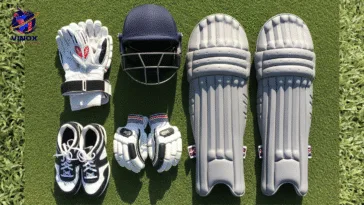Bowed Blade vs Flat Blade: Which Suits Modern-Day Power Hitting?
Cricket bats have evolved over the years to match the demands of modern gameplay, especially with the rise of T20 cricket and its emphasis on explosive power hitting. One of the key debates among players, bat manufacturers, and enthusiasts is the choice between a bowed blade and a flat blade. This ongoing discussion—Bowed Blade vs Flat Blade—highlights how each design offers unique benefits and caters to different playing techniques. But which one is truly more suited for the power-packed style of modern cricket?
In this blog post, we’ll explore the differences between bowed and flat blades, their advantages, drawbacks, and ultimately, which bat shape is more aligned with today’s power-hitting requirements.
Explore premium bowed and flat blade cricket bats now at Vinox Sports – crafted for modern power hitters.
Understanding the Blade Types
What is a Bowed Blade?
A bowed blade features a curved profile from the handle to the toe. This curvature is more visible when you place the bat on a flat surface. The bow typically enhances pickup and creates a dynamic sweet spot that helps with powerful strokes.
Key features:
Prominent curve from handle to toe
Enhances pickup
Concentrates power toward the middle/lower part of the bat
What is a Flat Blade?
A flat blade, as the name suggests, has minimal or no curvature along its spine. The back and face are more level, offering a broader playing surface and a more traditional profile that some players still prefer.
Key features:
Straight spine with no pronounced curve
Larger hitting area
Even weight distribution
Power Hitting: The Heart of Modern Cricket
In modern-day cricket, especially T20 and franchise leagues like the IPL, Big Bash, and The Hundred, the emphasis is on:
Maximum power in minimum time
Clearing boundaries consistently
Innovative strokes and 360-degree play
To meet these needs, players demand bats that allow quicker pickup, optimized sweet spots, and minimal energy loss during big hits.
Bowed Blade: A Favorite for Power Hitters?
Advantages of Bowed Blade:
Enhanced Pickup
The curvature improves bat balance, especially for heavier bats. This helps power hitters swing faster without feeling the full weight.Dynamic Sweet Spot
The sweet spot in a bowed blade is more concentrated and aligned toward aggressive shots, especially lofted ones.Improved Hitting Angle
The bow naturally lifts the face angle, assisting in lifting the ball with less effort — ideal for lofted drives and slog sweeps.Aesthetic and Psychological Edge
Many players find bowed bats more visually aggressive, boosting their confidence at the crease.
Drawbacks of Bowed Blade:
Less forgiving on mistimed shots compared to flatter blades
Can be tricky to control for traditional stroke makers who rely on timing more than power
Flat Blade: Reliable and Versatile
Advantages of Flat Blade:
Larger Hitting Area
The flat surface provides a bigger playing area, reducing the chances of mishits.Better for Technical Players
Ideal for players who value timing and placement over brute force.Consistent Weight Distribution
Provides stability and uniformity in stroke play.
Drawbacks of Flat Blade:
Pickup can feel heavier than bowed bats, especially in thicker profiles
Less dynamic sweet spot, which may limit explosive hitting capability
Doesn’t assist much in aerial shots unless backed by strong wrists and perfect timing
Which Blade Do Modern Cricketers Prefer?
The majority of today’s power hitters prefer the bowed blade, and for good reason:
Andre Russell, Hardik Pandya, Liam Livingstone, and other explosive players opt for bowed blades because they allow maximum power transfer with minimal effort.
The bow helps in generating top spin and elevation, key for clearing the inner circle and reaching the boundary line.
Bowed blades also support the bottom-hand dominance seen in most modern hitters.
However, some top-order players who rely on finesse—like Joe Root or Babar Azam—may still lean toward flat blades for better control and stroke placement.
Choosing the Right Blade: What to Consider
Your Playing Style
Power hitters = Bowed Blade
Stroke players = Flat Blade
Batting Position
Finishers and middle-order hitters often benefit from bowed blades
Openers might prefer flat blades for longer innings and timing
Pitch Conditions
On bouncy pitches, bowed blades help loft the ball
On slower tracks, flat blades may provide more control
Weight and Balance Preference
If you like light pickup, the bowed blade is for you
If you prefer uniform weight distribution, go flat
Final Verdict: Bowed Blade Wins for Power Hitting
While both blade types have their place in cricket, the bowed blade edges ahead for modern-day power hitting. It’s built for aggression, fast pickup, and explosive performance—perfect for the evolving demands of the game. The slightly raised sweet spot and curvature help players get under the ball more easily, a crucial aspect of T20 and ODI formats.
Yet, the final decision depends on your personal comfort, style, and role in the team. Try both styles if possible, and let your bat complement your natural game.





 No products in the cart.
No products in the cart.